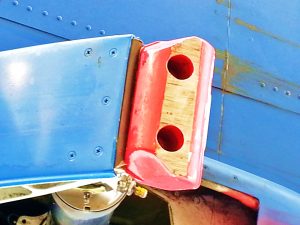Before the flight of every aircraft there is a procedure carried out by the crew. In commercial aviation it is commonly referred to as ‘the walk round’. The function is to act as a final visual inspection of the airframe and engines prior to flight; there will be no further opportunity to inspect the ship. Given the importance of such a task, it is worrying that some pilots appear to treat it so casually.

Of course those pilots are aware that the engineering/maintenance team have already done their final checks on the aircraft. Even so the principle of duplicate checks is exactly that – in our industry which is safety-led, nothing should be left to chance. In some airlines (Alitalia for example) it is ordained that the Commander must perform the exterior inspection, which gives a sense of priority. In other airline SOPs it is written that the task ‘may be delegated to the First Officer’ – which again indicates that the final responsibility still rests with the Skipper. This is correct actually because it is the PIC who signs the Techlog (a legal document) to formally accept the aircraft for flight. So, in a two pilot operation, what often occurs is that the Pilot Flying (PF) sets up the cockpit, while the Pilot Monitoring (PM) carries out the external check including monitoring/observing fuelling and baggage loading.
I think I have lost count now of the number of FOs who return to the cockpit having carried out the walk round and who either give no report at all, or whose response to my question of “External check okay?” is something along the lines of: “Yeah, two wings, two engines, ya’know, the usual…” I would like to think that it’s a symptom of modern dispatch reliability and the fact that there are seldom any faults at all with the airliners we operate, but perhaps I was trained in an earlier age. As FOs under training it was ingrained in our psyche that after carrying out the walk round check you always made a short, but formal report to the Captain. Words to the effect, “External check is good, wheel well needs a wash, fuelling completed, aft hold empty”. Even now as a matter of courtesy and as part of good CRM, I ensure that I do this myself when returning to the flightdeck for the benefit of the other pilot.
*
With multi-sector days and a heavy flying roster, I understand there is a tendency towards complacency, especially when you are inspecting the same aircraft (or type) several days in a row without seeing anything unusual. Let us not forget that the operating environment will also play a part. When it is cold and wet outside – maybe it is nighttime – nobody wants to spend too long ‘inspecting’ the aircraft. However there are some important issues which should be borne in mind. Take the Outflow Valve for example – all airliners have one in the hull. Located at the underside aft fuselage, it has electrically operated doors which control an aperture of maybe 30cm x 30cm. It will have driven automatically to the full-open position after the previous flight to depressurize the cabin and therefore that is the state you are expecting to see – both doors wide open. Say for example that it was the first flight of the day and the doors were partially or nearly closed… This should ring an alarm in your brain because something is definitely wrong here. Think back to the Helios B737 accident (note 2) when the crew took off with the pressurisation system in manual – that Outflow Valve was partially closed and that surely MUST have been visible to the pilot doing the walk round. There was a lost opportunity to prevent a catastrophic series of events. Sadly the crew missed other chances too which lead to the slow depressurisation of the cabin as they climbed and the ultimate loss of all lives onboard.
Also at the rear of the aircraft, often the cargo door to the aft hold is closed. In the shorthaul operation with which I am most familiar currently, the rear hold is normally empty, but if I don’t check how will I know? Fortunately with the 737 it is possible to open the door from the ground without special equipment, other types require a belt-loader to climb on or steps. Only by visually inspecting that compartment can you be certain it is empty. There have been instances in the past when airliners have departed with freight in there which should have been offloaded. If not included in the current loading/trim calculation, then you risk an out-of-trim condition in flight or something much worse.
While on the subject of cargo doors, it is worth paying close attention to the external surface of the door itself. Pre-existing damage (scratches, slight dents etc) will already be marked by engineering and therefore will have been recorded in the Dent and Buckle chart/notes in the aircraft Techlog. If there is a fresh scratch or dent this requires further maintenance input to sign off before flight. If your walkround is prior to the first flight with this airframe then at least you are able to say it happened before you signed for the aeroplane!
Moreover, on some airliners with a long fuselage there is sometimes a tail-skid fitted by the manufacturer underneath the fuselage, to protect the structure of the hull in the event of contact with the runway during take-off or landing. It is essential that this is included in your inspection, because if the paint is worn away and you can see bright/shiny aluminium there, it is evidence of a previous tailscrape. If you miss this before you take responsibility for the machine, then later on you might have difficulty proving it didn’t occur on your flight…
In fact while working for a freight airline in the past I had exactly this situation. Fortunately the hull was blue and the tailskid painted bright red so it was easy to see if any paint was missing. I immediately called maintenance and they sent an engineer. I explained the problem, but as his first language wasn’t English I thought it better to show him. He came with me to the rear of the aircraft – we looked up at the tailskid (see photo) with its red paint missing and the underside of the skid worn flat with aluminium showing. He smiled at me and said: “Ees hokay Captain, Ees normal!” At this I burst out laughing: “Erm, no it IS NOT NORMAL!” I said patiently, “you can see where the paint has worn away underneath when the skid has been touching the runway doing 150 miles per hour!” He remained unconvinced however and insisted that this was normal. He explained to me that the paint blew off in the wind in flight, which resulted in my uncontrolled mirth, much to his surprise. I couldn’t stop laughing. I responded that I would make an entry in the Techlog now BEFORE I even flew the aircraft and had the photos to prove it. “Engineer must sign it off… AND repaint red paint!” I was adamant. Eventually he acceded and went away to bring another technician to do the tailscrape checks and sign-off the Techlog.
On his return with the red paint and the brush (plus the ladders of course) he once again pointed out that it was pointless, because the paint would blow off in flight. Not only that, but he convinced the FO to tell me this in English: “Yes Captain, it will be gone when we arrive in London, the paint blows off in flight, that is what has happened…” I tried to keep a straight face (he was deadly serious) as I said, “No my friend, paint does not blow off the aircraft in flight or else all the aeroplanes we fly would be bare metal, trust me. In the past 30 years I have not seen it happen yet…. But there’s always a first time!”
Sure enough, after landing in London Stansted some 5 hours later we both visited the rear of the aircraft together again. The newly applied red paint was still intact – the funniest thing was the look on the FO’s face. He was stunned! That’s the great thing about flying aeroplanes for a living; we never stop learning new stuff.
*
The moral of the story is don’t skimp on the external checks. They are a vital layer of defence in our continuous attempts to keep the operation safe. Properly completed walk rounds are an essential part of trapping Errors and managing Threats – we must not just “Kick the tires and light the fires…”
James McBride © FEB 2018, Denmark
Note 1. “Kick the tires and light the fires” – US military slang, often used by fighter pilots.
Note 2. Helios Airways flight 522 – 14th August 2005.







